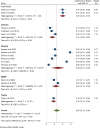The magnitude of preconception care utilization and associated factors among women in Ethiopia: systematic review and meta-analysis, 2024
- PMID: 40057689
- PMCID: PMC11889754
- DOI: 10.1186/s12884-025-07394-6
The magnitude of preconception care utilization and associated factors among women in Ethiopia: systematic review and meta-analysis, 2024
Abstract
Background: Nowadays globally a woman dies every two minutes, and a neonate dies even in every 12 s, and more than two-thirds of these maternal deaths are preventable. Preconception care is a continuum of maternity care which is one of the proven strategies to reduce not only maternal mortality and morbidity but also neonatal mortality and morbidity by improving women's health. Therefore, this study aimed to assess the pooled magnitude of preconception care utilization and its associated factors among women in Ethiopia.
Methods: Searching of studies done through PubMed, Medline, Embase, Cochrane Library, List of References, and Google Scholar. Duplication of records was removed through the Endnote software manager. The Preferred Reporting Items for Systematic Review and Meta-Analysis (PRISMA) godliness was adhered to. A Newcastle- Ottawa Scale (NOS) assessment tool was used to evaluate the quality of studies. Analysis was performed using a random effect model with STATA 17 version software. Egger's weighted regression and I2 test were used to evaluate publication bias and heterogeneity respectively.
Results: In this systematic review and meta-analysis, a total of 6,808 women from 14 primary studies were included. The overall pooled magnitude of preconception care utilization in Ethiopia was 26% (95% CI: 18, 34). Educational status (OR = 2.18, 95%CI 1.54, 2.82), adequate knowledge of women regarding preconception care (OR = 2.69, 95%CI 1.90, 3.48), pre-existing medical illness (OR = 4.79, 95%CI 2.61, 6.06), history of adverse pregnancy outcome (OR = 3.18, 95%CI 2.74, 3.62), and husband /partner support (OR = 3.26, 95%CI 1.55, 4.97) were the identified predictors of utilization of preconception care.
Conclusion: The overall magnitude of preconception care utilization among Ethiopian women was significantly low. Educational status of women, knowledge of women regarding Preconception care, history of adverse birth outcome, pre-existing chronic medical illness, and either psychological or financial husband support were the identified predictors of preconception care utilization. Thus, healthcare organizations should work on strategies to improve the utilization of preconception care. Moreover, advocating for better women's education, awareness creation, and encouraging male involvement is very essential to optimize service utilization.
Prospero registration: CRD42023492995 registered on 23/12/2023.
Keywords: Ethiopia; Meta-analysis; Preconception care; Systematic review; Utilization; Women.
© 2025. The Author(s).
Conflict of interest statement
Declarations. Ethics approval and consent for participants: Not applicable. Consent for publication: Not applicable. Prospero registration: Registered on December 2023 with CRD42023492995. Competing interests: The authors declare no competing interests.
Figures










Similar articles
-
Knowledge of preconception care and its association with family planning utilization among women in Ethiopia: meta-analysis.Sci Rep. 2021 May 25;11(1):10909. doi: 10.1038/s41598-021-89819-8. Sci Rep. 2021. PMID: 34035339 Free PMC article.
-
The magnitude and associated factors of immediate postpartum anemia among women who gave birth in Ethiopia: systematic review and meta-analysis, 2023.BMC Pregnancy Childbirth. 2024 Apr 25;24(1):317. doi: 10.1186/s12884-024-06495-y. BMC Pregnancy Childbirth. 2024. PMID: 38664625 Free PMC article.
-
Mothers' utilization and associated factors of preconception care in Africa, a systematic review and meta-analysis.PLoS One. 2021 Jul 23;16(7):e0254935. doi: 10.1371/journal.pone.0254935. eCollection 2021. PLoS One. 2021. PMID: 34297760 Free PMC article.
-
Determinants of practice of preconception care among women of reproductive age group in southern Ethiopia, 2020: content analysis.Reprod Health. 2021 May 21;18(1):100. doi: 10.1186/s12978-021-01154-3. Reprod Health. 2021. PMID: 34020669 Free PMC article.
-
Cervical cancer screening utilization and predictors among eligible women in Ethiopia: A systematic review and meta-analysis.PLoS One. 2021 Nov 4;16(11):e0259339. doi: 10.1371/journal.pone.0259339. eCollection 2021. PLoS One. 2021. PMID: 34735507 Free PMC article.
References
-
- Gray F, Cunningham KL. William Obstetrics, Availabel at: https://www.amazon.com/Williams-Obstetrics-25th-Gary-Cunningham/dp/12596..., access on Jan 16, 2024 2018:323.
-
- Health GoBMO. Preconception care and Obstetrics, available at: chrome-extension://https://platform.who.int/docs/default-source/mca-documents/policy-docume..., access on Jan 16, 2024. 2018:12.
-
- Organization WH. Preconception care to reduce maternal and childhood mortality and morbidity: policy brief. World Health Organization; 2013.
-
- Organization WH. World health statistics overview 2019: monitoring health for the SDGs, sustainable development goals. World Health Organization; 2019.
-
- Ethiopia Moho. Obstetric management protocol for hospitals. 2021.
Publication types
MeSH terms
LinkOut - more resources
Full Text Sources
Medical

